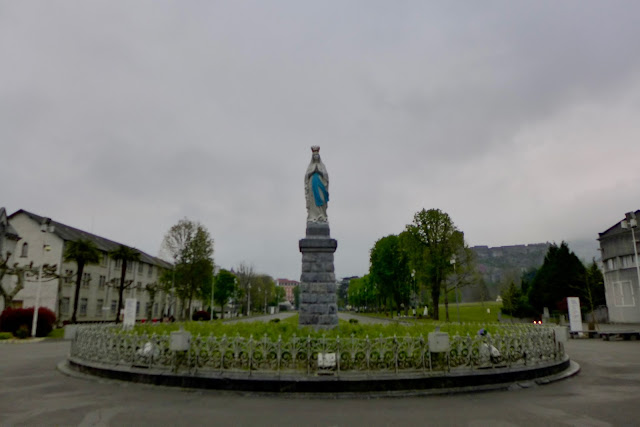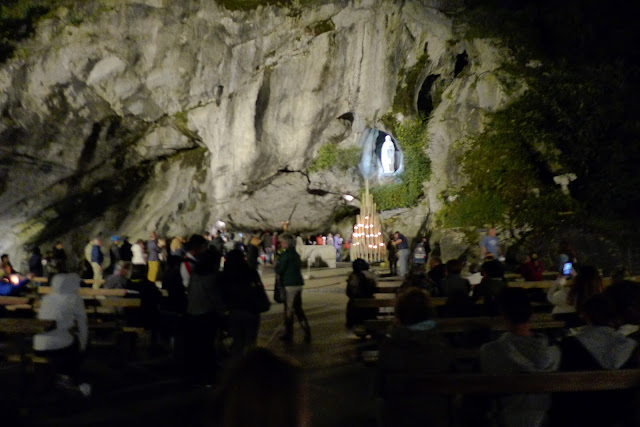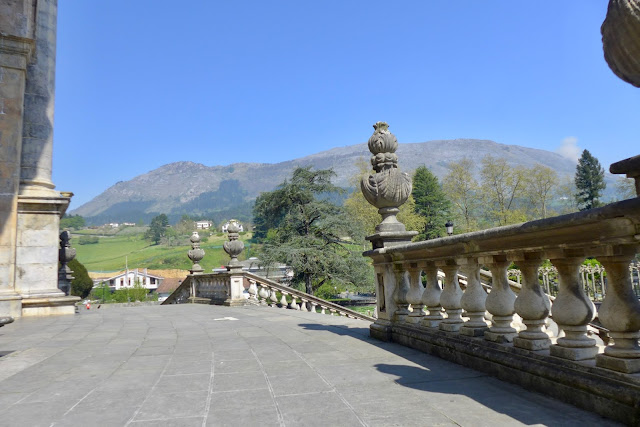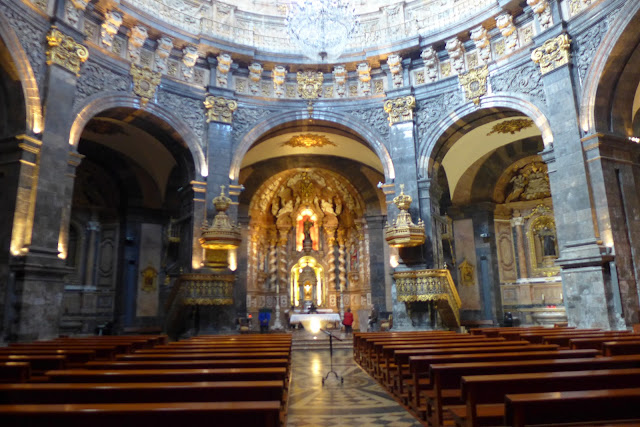What started out as a small market town in the southwestern part of France, located at the foothills of the pyrenees, had become a very special place for Marian apparitions, which began in 1858. A young girl who was gathering wood - Bernadette Soubirous - had an exceptional experience of having a vision of a beautiful Lady at the Grotto of Masabielle. She came from a poor family, she was sickly and had not received much eduction. But she was chosen by Our Blessed Mother for a very special reason - the be the messenger to reveal to the world the messages she received, that was meant for all of us.
Initially, the Lady in her vision did not identify herself, but she invited Bernadette to return for several more days, totaling eighteen times. To these invitations, Bernadette faithfully complied.
-----
The town was previously known as Chateau fort de Lourdes, where this fortified castle was built, rising from a rocky steep slope along the riverbank. Our visit to Lourdes coincided with the April full moon.
AT THE LOURDES SHRINE
The rotund just before getting to the heart of the Lourdes Shrine
The Sanctuary (Basilica) of Our Lady of Lourdes
Here is a synopsis of the interactions Bernadette had with the beautiful Lady:
"...During the third apparition, on 18th February, the Virgin spoke for the first time: “what I have to say to you does not have to be written down”. This means that Mary wished to communicate with Bernadette in a loving heart to heart way. From the very start, Bernadette was invited to open the depths of her heart to this message of love.
- Bernadette was overwhelmed by the second statement of the Virgin Mary: “Would you be so kind as to come here for fifteen days?” It is the first time that Bernadette was addressed in a formal way. She felt she was respected and loved,... We are all worthy of respect in the eyes of God, because He loves each one of us.
- The third statement of the Virgin was: “I do not promise to make you happy in this world but in the other.” When Jesus, in the Gospel, invites us to discover the Kingdom of Heaven, He invites us to discover the “another world” within our world as it is. Wherever there is love, God is present.
"...During the first seven apparitions, Bernadette’s face always radiated joy, happiness and light. However between the eight and twelfth apparitions, everything changed: Bernadette’s face became harsh, sad, and sorrowful, and above all she performed incomprehensible gestures… She moved on her knees to the back of the Grotto. She kissed the dirty repulsive ground of the Grotto. She ate some bitter plants. She scraped the ground three times trying to drink the muddy water at the back of the Grotto...she took mud in her hands and smeared it on her face... What did all these mean? Nobody understood! Nonetheless, here we are at the heart of the “Message of Lourdes”.
- BIBLICAL DIMENSIONS:
...Bernadette ACTS OUT the INCARNATIOM, the PASSION and DEATH of CHRIST Moving on her knees to the back of the Grotto: this action recalls the INCARNATION, God humbles himself to become human.
.....EATING the BITTER HERBS at the back of the Grotto recalls the JEWISH TRADITION found in the ancient texts.
.....SMEARING HER FACE with MUD: when the prophet Isaiah speaks to us about Christ, he depicts Him as “the SUFFERING SERVANT”.
"During the ninth apparition, “the Lady” asked Bernadette to scrape the soil, saying to her: “Go to the spring, drink of it and wash yourself there”. By these actions, the mystery of the heart of Jesus is revealed for us: “A soldier pierced his heart with his lance and there immediately flowed out blood and water.” The herbs and the mud represent the heart of man wounded by sin. However, in the deepest recesses of that heart, there lies the very life of God signified by the Spring. Bernadette is asked: “Did the ‘Lady’ say anything to you?” She replied: “Yes, from time to time, She said: “penance, penance, penance. Pray for sinners”. By “Penance”, one must understand conversion...consists of turning one’s heart towards God and towards our brothers and sisters, as Christ taught us.
"During the thirteenth apparition, Mary said to Bernadette: “Go, tell the priests and that people should come here in procession and to build a chapel here.”
- “Come here in procession” means accompanying our brothers and sisters in this life.
- “Build a chapel here.” In Lourdes, chapels were built to accommodate the crowds of pilgrims. The chapel is the “Church” that we ought to build where we are.
"On 25th March 1858, the day of the sixteenth apparition, Bernadette asked the “Lady” her name. The “Lady” replied in the local dialect: “Que soy era Immaculada Counceptiou”, which means “I am the Immaculate Conception”. The Immaculate Conception is “Mary conceived without sin, by the merits of the Cross of Christ”... Bernadette went to see the Parish priest straight away to give him the name of the “Lady”. He then realized it was the Mother of God who was appearing in the Grotto. Later, Mgr Laurence, Bishop of Tarbes, authenticated this revelation."
"...During the third apparition, on 18th February, the Virgin spoke for the first time: “what I have to say to you does not have to be written down”. This means that Mary wished to communicate with Bernadette in a loving heart to heart way. From the very start, Bernadette was invited to open the depths of her heart to this message of love.
- Bernadette was overwhelmed by the second statement of the Virgin Mary: “Would you be so kind as to come here for fifteen days?” It is the first time that Bernadette was addressed in a formal way. She felt she was respected and loved,... We are all worthy of respect in the eyes of God, because He loves each one of us.
- The third statement of the Virgin was: “I do not promise to make you happy in this world but in the other.” When Jesus, in the Gospel, invites us to discover the Kingdom of Heaven, He invites us to discover the “another world” within our world as it is. Wherever there is love, God is present.
"...During the first seven apparitions, Bernadette’s face always radiated joy, happiness and light. However between the eight and twelfth apparitions, everything changed: Bernadette’s face became harsh, sad, and sorrowful, and above all she performed incomprehensible gestures… She moved on her knees to the back of the Grotto. She kissed the dirty repulsive ground of the Grotto. She ate some bitter plants. She scraped the ground three times trying to drink the muddy water at the back of the Grotto...she took mud in her hands and smeared it on her face... What did all these mean? Nobody understood! Nonetheless, here we are at the heart of the “Message of Lourdes”.
- BIBLICAL DIMENSIONS:
...Bernadette ACTS OUT the INCARNATIOM, the PASSION and DEATH of CHRIST Moving on her knees to the back of the Grotto: this action recalls the INCARNATION, God humbles himself to become human.
.....EATING the BITTER HERBS at the back of the Grotto recalls the JEWISH TRADITION found in the ancient texts.
.....SMEARING HER FACE with MUD: when the prophet Isaiah speaks to us about Christ, he depicts Him as “the SUFFERING SERVANT”.
"During the ninth apparition, “the Lady” asked Bernadette to scrape the soil, saying to her: “Go to the spring, drink of it and wash yourself there”. By these actions, the mystery of the heart of Jesus is revealed for us: “A soldier pierced his heart with his lance and there immediately flowed out blood and water.” The herbs and the mud represent the heart of man wounded by sin. However, in the deepest recesses of that heart, there lies the very life of God signified by the Spring. Bernadette is asked: “Did the ‘Lady’ say anything to you?” She replied: “Yes, from time to time, She said: “penance, penance, penance. Pray for sinners”. By “Penance”, one must understand conversion...consists of turning one’s heart towards God and towards our brothers and sisters, as Christ taught us.
"During the thirteenth apparition, Mary said to Bernadette: “Go, tell the priests and that people should come here in procession and to build a chapel here.”
- “Come here in procession” means accompanying our brothers and sisters in this life.
- “Build a chapel here.” In Lourdes, chapels were built to accommodate the crowds of pilgrims. The chapel is the “Church” that we ought to build where we are.
"On 25th March 1858, the day of the sixteenth apparition, Bernadette asked the “Lady” her name. The “Lady” replied in the local dialect: “Que soy era Immaculada Counceptiou”, which means “I am the Immaculate Conception”. The Immaculate Conception is “Mary conceived without sin, by the merits of the Cross of Christ”... Bernadette went to see the Parish priest straight away to give him the name of the “Lady”. He then realized it was the Mother of God who was appearing in the Grotto. Later, Mgr Laurence, Bishop of Tarbes, authenticated this revelation."
-----
It had only been four years before when the dogma on the Immaculate Conception had been defined under the papacy of Pope Pius IX, in 1854. Bernadette, whose education was limited, had no idea what Our Lady meant when she identified herself. But, still she did as Our Lady had requested her to do.
It had only been four years before when the dogma on the Immaculate Conception had been defined under the papacy of Pope Pius IX, in 1854. Bernadette, whose education was limited, had no idea what Our Lady meant when she identified herself. But, still she did as Our Lady had requested her to do.
The mosaic design depicting Our Lady at the dome above the altar of the sanctuary
One of the most attended activities in Lourdes is the torchlight procession. Pilgrims from all over the world gather around before 9:00 p.m. (from April to October) for this, with rosaries in hand.
My companions and I joined the crowd, as the sick and the able came together and were organized to get into designated places.
where some groups and organizations were identified by banners or flags.
A statue of Our Lady of Lourdes, resting on a palanquin, had been prepared for the procession.
The mosaic design on the façade of the sanctuary by Fr. Marko Rupnik - a Jesuit, Slovenian priest - was added in 2008. The design embodies the Luminous Mysteries of the Holy Rosary, depicting the "Wedding at Cana" on the exterior entrance leading to the lower basilica. Sadly, it has been embroiled in controversy in the last couple of years.
As of July, 2024, Bishop Jean Marc-Micas of Tarbes and Lourdes, originally, wanted the mosaic removed after Fr. Rupnik was excommunicated by the Vatican in May 2020, after several women accused him of sexual, psychological, and spiritual abuses dating to 30 years back. However, after meeting with the pope on June 20, 2024 with regards to the fate of the artworks of Fr. Rupnik (an abuser) which are all over the world, the good bishop decided that the mosaic art in the Lourdes Basilica will no longer be lit up during the torchlight procession, as a first step to take. As you can imagine, this decision was not received well by the abused victims.
In May 2023, a commission - composed of abused victims, sacred-art specialists, lawyers, and chaplains - was organized by Bishop Micas to decide what to do with the Rupnik mosaic. That has been almost two years ago. For more information about what has become of the case of Fr. Rupnik, please read about it here. I pray - unto the loving care of Our Lady of Lourdes, may the abuse victims find healing.
In May 2023, a commission - composed of abused victims, sacred-art specialists, lawyers, and chaplains - was organized by Bishop Micas to decide what to do with the Rupnik mosaic. That has been almost two years ago. For more information about what has become of the case of Fr. Rupnik, please read about it here. I pray - unto the loving care of Our Lady of Lourdes, may the abuse victims find healing.
Our Blessed Lady led the way...

while we prayed the rosary, silently raising up our pleas and intentions for healing, for resolutions to problems, or in thanksgiving.


while we prayed the rosary, silently raising up our pleas and intentions for healing, for resolutions to problems, or in thanksgiving.


and ended at the Masabielle Grotto...

after which time, many of the pilgrims lined up to see the original spot from which the healing waters of Lourdes had flowed from, and continues to up to this day.

after which time, many of the pilgrims lined up to see the original spot from which the healing waters of Lourdes had flowed from, and continues to up to this day.
We called it a night as it was getting late and went back to our hotel. We were booked for two nights at Hotel Christina, which was well situated around souvenir shops and located near the Basilica of Our Lady of Lourdes. The next day, we had enough time to go around and shop for our religious articles, attend mass, go to confession, and light candles.
With the close proximity of our hotel to the basilica, it only took us 10 minutes to walk in by taking the side gate.We went back to the grotto to sit and pray, and to peruse...
as we followed the line to go around the ground level of the cave beneath the grotto. While walking along the wall of the cave, we were able to wipe our handkerchiefs, or use our hands to gather some moisture trickling down into drops of water to bless ourselves.
Here is the original spot where Bernadette was asked by Our Lady to scratch the ground from where the healing water started to flow.
Under this banc (French word for bench) in the grotto grounds, we saw this spot where Bernadette had prayed on February 11, 1858, during her initial encounter and her subsequent encounters with the Lady...;where she eventually found out who the beautiful Lady was - the "Immaculate Conception."

Near the grotto, to the left were faucets from where the pilgrims could collect the healing water from Lourdes into containers; or, collect the water with capped hands to drink, to wash their faces or body parts that were being lifted up to Our Lady's intercession for healing.

Near the grotto, to the left were faucets from where the pilgrims could collect the healing water from Lourdes into containers; or, collect the water with capped hands to drink, to wash their faces or body parts that were being lifted up to Our Lady's intercession for healing.
Some of us from our group decided to join the line, early in the morning, to get to the waiting area, to be dunked in the bath stalls.
Gave de Pau riverbank, near the grotto
As we bid adieu to Our Lady of Lourdes, we were on a spiritual high as we relished the time and the graces and blessings we received in our visit with her.
We were back on the road again to continue our pilgrimage to more sites, as we headed back to Garabandal, along the route to Cantabria.
As much as 70 miraculous healings have been investigated and approved by the Catholic Church; though, many, many more healings have been received by pilgrims who go there, or pray to Our Lady of Lourdes, where ever they are, to intercede for them for healing in mind, body and spirit.
The Lourdes Shrine ranks as one of the most visited sites where anywhere from four to six million pilgrims are welcomed each year. Be one of them in 2025!
For more information: https://www.lourdes-france.org/en/
The Lourdes Shrine ranks as one of the most visited sites where anywhere from four to six million pilgrims are welcomed each year. Be one of them in 2025!
For more information: https://www.lourdes-france.org/en/













































